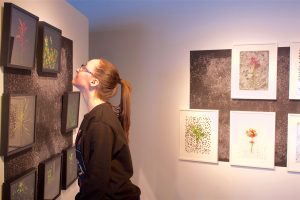By Ilhan Raage
Editor-in-Chief

“Kathryn Christenson observes the ìSea Legsî exhibit at the RCTC Art Gallery.” (Echo photo by Abigail Furutani)
The RCTC gallery now features an exhibit that explores adaptability in response to an ever-shifting environmental baseline.
ìSea Legsî by Kathleen Hawkes was inspired by the environment and the artistís fear and uneasiness about humanís future on this planet.
ìI think the environment is/will be the big challenge of our generation. But the problem is so large and chaotic that it feels paralyzing to think about and/or even attempt to solve,î Hawkes said. ìSolutions will need to be collaborative, plural, and have many, many facets.î
To explain her art, Hawkes said ìa better presentation of my thinking would be a sketched concept map, erased and rewritten many times over.î
Her work features specific references to ever-changing ways that people compensate for a lack or an abundance of water. Other works stand as metaphors for scarcity and depletion of resources.
ìThe precariousness of our environmental future remains an overwhelming tangled web that is not easily solved or explained,î Hawkes said. ìThus, I have not fully reconciled the seemingly disparate concepts and imagery that exist together in this exhibition.î
Hawkes is interested in how the environment has changed because of human civilization, on a micro and macro scale. An example she used is how the effect of micro pieces of plastic in water is irreversible.
As to how people should view her work, Hawkes said, ìI think everyone always brings something unique with them when they view an artwork.î
ìI think the role of artwork is really more to dance around the edges of a real-life problem and provoke people to think differently or ask questions. That is really it: so often art raises more questions than it answers,î Hawkes said, ìVisual art is really good at reflecting the complexity of a large problem or phenomena. So, I hope this exhibition gives viewers a new or renewed perspective.î
